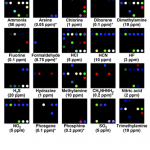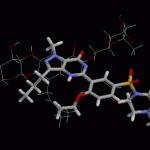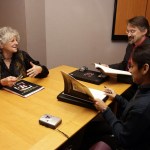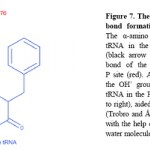Chemistry
I've just started my book tour for The Poisoner's Handbook and people seem to be wondering why I (a friendly mother-of-two) am so fascinated by poisons. I admit to a fascination with murder mysteries (count on me later in this blog to write about Agatha Christie). I share my affection for forensic dramas on television. I talk about the thrill of discovering two forgotten and quite heroic forensic scientists from jazz-age New York.
And then I confess that I love chemistry - the most beautiful, the most fundamental, and on occasion the most sinister of all sciences - and…
Researchers at the University of Illinois, Urbana-Champaign have developed a way to compare aromas visually using specially developed inks.
Kenneth Suslick and his colleagues used tiny squares of polymer film that hold 36 drops of carefully designed dyes. These pigments change colour when exposed to various chemicals. The result is a cheap system for detecting very low concentrations of gaseous compounds. The cards can be used like a physicist's radiation dose badge to alert lab workers when they have been exposed to toxic gases.
As shown above, the cards can be used to give each…
In our last post, we discussed a recent USPTO ruling that rejected a claim of the Pfizer patent on the erectile dysfunction drug, sildenafil (Viagra®), to a novel oral treatment for the disorder. The patent appeals panel ruled that the existence of horny goat weed, a traditional Chinese medicine used orally for impotence, was grounds for rejection of the claim.
Frequent commenter daedalus4u pulled out US Patent #6,469,012 (filed Mar 4 1996, issued Oct 22 2002) wherein the relevant claim 24 reads:
A method of treating erectile dysfunction in a male human, comprising orally administering to a…
Last week, The Poisoner's Handbook got a great, pre-publication review in one of my favorite magazines, New Scientist. I was thrilled - and relieved. Hard to say which came first. The week before publication - the book's official date is Feb. 22 - always makes me a little crazy.
But much as I like my work being called "fascinating" (and I do, I do), it was the closing sentence of the review that really spoke to me: "Alas, sometimes the poisoners we seek are ourselves." Collins was referring to the findings by the 1920s toxicologist in my book that carbon monoxide was…
The elder Free-Ride offspring is lobbying to try an experiment this weekend. The working title of the protocol is "homemade soda*" but I suspect it may be described differently in the final report.
Dr. Free-Ride: Tell me about the experiment that you proposed to your teacher.
Elder Free-Ride offspring: I'll mix four cups of baking soda and vinegar and put each in its own bucket to keep the bubbles from spilling over, and take what remains in the cup and add fruit juice to it, and taste it, and if it's not sweet enough add sugar to it, and then pass it off as soda!
Dr. Free-Ride: Tell me more…
In 1854, the essayist Henry David Thoreau published an ode to a morning fire: "Light-winged Smoke, Icarian bird... Lark without song, and messenger of dawn." Scientists, of course, saw the hazing blue of wood smoke - or any smoke derived from burning plant material - as something less poetic. In particular, the smoke from dried leaves of the tobacco plant attracted serious attention from chemists by the end of the 19th century.
Victorian scientists had, for instance, calculated that cigarette smoke was about four percent carbon monoxide, a poisonous gas which directly interferes with…
tags: How it's Made: Aluminum Foil, aluminum, material science, chemistry, technology, streaming video
The video shows the process of producing everyday use aluminum foil from huge, raw aluminum ingots.
tags: How It's Made: Bread, baking, agriculture, chemistry, food science, technology, streaming video
This interesting video shows how bread is made in large, mechanized factories: from mixing the ingredients to shipping it out for consumption.
Last week in Stockholm (and Oslo), the 2009 Nobel Prize winners were gloriously hosted while giving their lectures and receiving their medals and diplomas. In Chemistry this year, the Nobel was shared by Venkatraman Ramakrishnan, Thomas A Steitz, and Ada E Yonath for their studies on the structure and function of the ribosome, a remarkable nucleoprotein complex that catalyzes the rapid, coordinated formation of peptide bonds as instructed by messenger RNA. My post on the day of the announcement in October was designed to counter the inevitable (and now realized) criticisms that the prize was…
Dr. Free-Ride: Any ideas for tomorrow's sprog blog?
Younger offspring: I wanted to do how photosynthesis works.
Dr. Free-Ride: Did you do any research on that since last week?
Younger offspring: I don't do research.
Dr. Free-Ride: You don't do research?! How do you do science, then?
Younger offspring: I don't research stuff.
Dr. Free-Ride: Well, then, how do you learn stuff?
Younger offspring: (after a pause) I didn't do research about how photosynthesis works at night.
Dr. Free-Ride: Well, but does it work at night? 'Cause, what is photosynthesis?
Younger offspring: The moon could make it…
tags: atoms, teaching, pets, dogs, chemistry, streaming video
A crack team of PhD-trained golden retrievers illustrate the structure of atoms -- the particles that make up everything around you. They also show how atoms are weirder than you might think.
The Free-Ride offspring have been rather busy recently, what with the approach of Hallowe'en and the rapidly approaching end of their regular soccer season. (The post-season, of course, falls after this weekend's time change, which means practices will either be earlier or darker.) Still, each of them has found time for an experiment they'd like to share.
From the elder Free-Ride offspring, a model of the water cycle:
What's pictured here is a sketch; the actual set-up is at school.
The elder Free-Ride offspring carefully added soil to an empty 2 liter bottle, followed by a sprinkling of…
Dr. Free-Ride: So, you know this Friday is Mole Day.
Elder offspring: It is? What does that mean exactly?
Dr. Free-Ride: Do you remember what a mole is? Not the animal, but the quantity.
Elder offspring: Not really.
Dr. Free-Ride's better half: It's a convenient unit of measure for things like atoms and molecules.
Dr. Free-Ride: Like eggs come in dozens and shoes come in pairs, molecules come in moles -- that's 6.02 x 1023.
Elder offspring: Whoa! That's a pretty big number.
Dr. Free-Ride's better half:Well, but atoms and molecules are pretty small. Can you imagine weighing out a single…
Because, of course, tomorrow is Mole Day. According to the National Mole Day Foundation:
Celebrated annually on October 23 from 6:02 a.m. to 6:02 p.m., Mole Day commemorates Avogadro's Number (6.02 x 10^23), which is a basic measuring unit in chemistry. Mole Day was created as a way to foster interest in chemistry. Schools throughout the United States and around the world celebrate Mole Day with various activities related to chemistry and/or moles.
Last year, I put up a post on Mole Day explaining the mole concept and why it matters in chemistry. But there was a little bit of grumbling…
In the use of immunopharmacotherapy to treat drug abuse, antigenic molecules are hitched to molecules of the drug to stimulate a future immune response against the drug itself; as DrugMonkey reported this week, a recently published paper offers hopeful evidence that it could be a potentially effective treatment against cocaine addiction, though he cautioned, "It is quite obviously not a silver bullet solution at present. And when you think about it a bit, it never will be." Later on, DrugMonkey looked at another study that tracked the contents of street ecstasy to determine how much actual…
Welcome visitors coming from a recommendation by Dr Carmen Drahl at C&ENtral Science, the blog of the American Chemical Society's Chemical & Engineering News (C&EN):
Terra Sig has a fantastic post about the chemistry prize. The money quote: "If I see electrons being pushed around, it's chemistry."
Thank you for the kind words, Dr Drahl. New readers, feel free to weigh in down in the comments as to your take on this year's Chemistry prize.
The 2009 Nobel Prize in Chemistry has been awarded to three amazing scientists who elucidated the chemical bond-by-chemical bond action of the…
tags: chemistry, elements, meet the elements, they might be giants, music video, streaming video
This is such a cute song that I would use it in my chemistry class if I was teaching this semester. This song, "Meet the Elements" is by the group, They Might be Giants, and it has a catchy tune that will help one to remember all those elements.
This week, while I hunkered down for the start of classes, Dr. Free-Ride's better half took the Free-Ride offspring camping.
They camped near Big Sur, which provided ample opportunities to hike near the ocean (and to swim in it). Indeed, on one of these hikes the first day out, they spotted some otters:
The Free-Ride offspring describe these as a mother and baby otter. I'm not sure that I'm ready to rule out the possibility that the parental otter here might be the father.
At one point, coming back to the campsite, they noticed some avian company:
The elder Free-Ride offspring thinks it…
I know that we have been very fortunate to attract a few new readers over the last year or so. For those, and as a reminder to others, I wanted to focus on some of my major blog influences. One of these is Derek Lowe, an early science blogger who is perhaps the only pharmaceutical company chemist who writes under his own name. Dr Lowe writes the blog, In The Pipeline.
Dr Lowe gives invaluable insights into the industry about companies large, small, and tiny, and provides on of the few places where scientists entering the job market can truly get a glimpse of what it's like to work for a…
That was it, we're back. After six inspiring days in Lindau, the Nobel Laureates Meeting 2009 has ended. Eight authors blogged about it on ScienceBlogs Germany, plus we had further blogging guests such as PZ Myers, Bora Zivkovic and Seema Singh.
I did not make myself heard in the last two days. That was due to a lack of wifi on the Isle of Mainau where we spent the last days. Nevertheless it is time now to sum up what our English bloggers had to offer you:
Sir Harold Kroto gave a video interview in which he talked about competition in science and the negative aspects of a Nobel Prize.
We…




